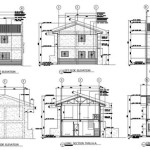In-Floor Plan Meaning: A Comprehensive Guide
In-floor plans, often referred to as radiant floor heating, have gained significant popularity in recent years as a highly efficient and comfortable way to heat living spaces. This innovative system involves embedding heating elements directly into the floor structure, delivering a gentle and even distribution of warmth throughout the room. This article delves into the meaning of in-floor plans, exploring their advantages, types, and installation process.
What is an In-Floor Plan?
An in-floor plan is a heating system where heating elements are installed within the floor structure, typically beneath the flooring material. These elements, which can be electric or hydronic (water-based), heat up and radiate heat upward, warming the entire room from the ground up. The system relies on the principle of convection, where warm air rises, creating a comfortable and consistent temperature throughout the space.
Advantages of In-Floor Heating
In-floor heating offers several advantages over traditional heating methods like baseboard heaters or forced-air systems.
1. Energy Efficiency
In-floor heating systems are known for their energy efficiency. Since heat is distributed from the floor, less energy is wasted heating the upper air, leading to lower energy consumption and reduced heating costs. Additionally, these systems can be zoned to heat specific areas independently, further optimizing energy usage.
2. Improved Comfort
In-floor heating provides a more comfortable and consistent temperature compared to other systems. The gentle and even heat distribution eliminates hot and cold spots often found in traditional heating systems. The warmth emanating from the floor creates a cozy and inviting atmosphere, especially for bare feet.
3. Health Benefits
In-floor heating systems are particularly beneficial for individuals with allergies or respiratory issues. As the heating elements are concealed within the floor, they do not circulate dust or allergens, reducing the risk of triggering allergic reactions or asthma symptoms. Additionally, the absence of forced air eliminates drafts, which can often exacerbate respiratory problems.
Types of In-Floor Heating Systems
There are two primary types of in-floor heating systems:
1. Electric In-Floor Heating
Electric in-floor heating systems use electric heating cables or mats embedded within the floor structure. These cables or mats are connected to a thermostat, which controls the temperature of the heating elements. Electric systems are relatively easy to install and are suitable for smaller areas like bathrooms and kitchens.
2. Hydronic In-Floor Heating
Hydronic in-floor heating systems use a network of pipes filled with heated water to provide warmth. Hot water is circulated from a boiler or heat pump through the pipes installed within the floor structure. Hydronic systems offer higher efficiency and are ideal for larger areas like living rooms and bedrooms.
Installation Process
The installation process for in-floor heating involves several steps that vary depending on the specific type of system and the existing floor structure. Generally, the process includes:
1. Planning and Preparation
The first step involves careful planning and preparation. This includes determining the desired heating zones, selecting the appropriate type of in-floor heating system, and ensuring proper insulation and subfloor preparation.
2. Installing the Heating Elements
Once preparation is complete, the heating elements are installed. For electric systems, cables or mats are laid out according to the planned heating zones. For hydronic systems, pipes are laid out and secured to the subfloor. The heating elements are then covered with a layer of concrete or a special leveling compound.
3. Flooring Installation
After the heating elements are installed, the final flooring material is installed. The type of flooring material compatible with in-floor heating varies depending on the system and its temperature capabilities. Some popular choices include ceramic tile, porcelain tile, engineered hardwood, and laminate flooring.
4. Testing and Commissioning
Once the installation is complete, the system is tested and commissioned. This involves verifying that the heating elements are functioning correctly and that the temperature can be controlled effectively. The installer will also instruct the homeowner on how to operate and maintain the in-floor heating system.
In conclusion, in-floor heating systems offer a highly efficient, comfortable, and healthy way to heat living spaces. They provide a range of advantages over traditional heating methods and are becoming increasingly popular as more homeowners prioritize energy efficiency and comfort. Choosing the right type of in-floor heating system and professional installation ensures optimal performance and longevity.

Floor Plan Wikipedia

Floor Plan Wikipedia

Floor Plan Wikipedia

Meaning Of Layout Off Topic Sketchup Community

Home Plan Buyers Learn How To Read A Floor Blueprint Blog Eplans Com

Home Plan Buyers Learn How To Read A Floor Blueprint Blog Eplans Com

15 Key Floor Plan Symbols 74 Architectural Abbreviations Foyr

Home Plan Buyers Learn How To Read A Floor Blueprint Blog Eplans Com

House Floor Plans Do You Know How To Read Them

Building 101 How To Read Floor Plans








